CADILLAC SEVILLE 1994 4.G Owners Manual
Manufacturer: CADILLAC, Model Year: 1994, Model line: SEVILLE, Model: CADILLAC SEVILLE 1994 4.GPages: 399, PDF Size: 21.33 MB
Page 301 of 399
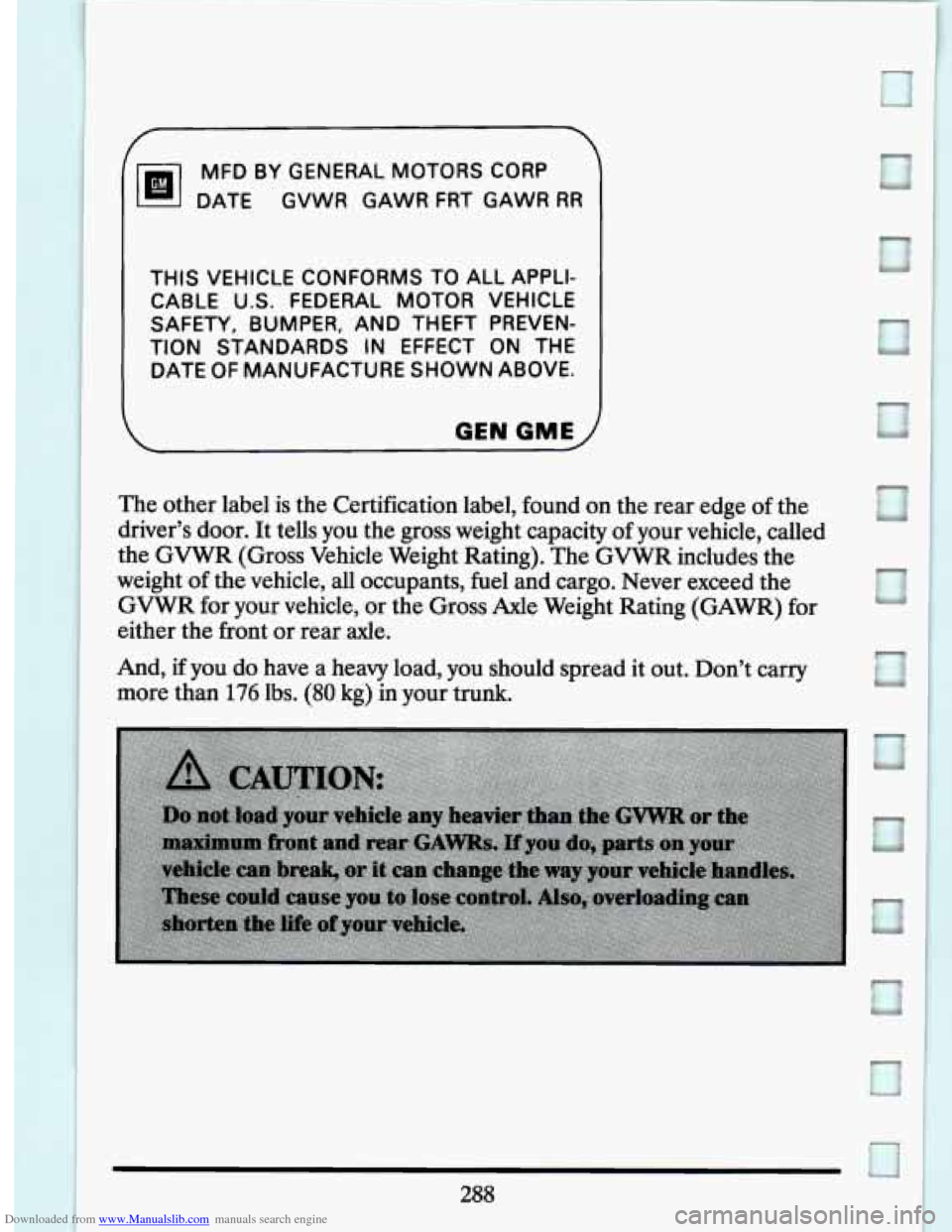
Downloaded from www.Manualslib.com manuals search engine MFD BY GENERAL MOTORS CORP
DATE GVWR GAWR FRT GAWR
RR
THIS VEHICLE CONFORMS TO ALL APPLI-
CABLE U.S. FEDERAL MOTOR VEHICLE
TION STANDARDS
IN EFFECT ON THE
DATE
OF MANUFACTURE SHOWN ABOVE.
SAFETY, BUMPER,
AND THEFT PREVEN-
GEN GME)
The other label is the Certification label, found on the rear edge of the
driver’s door. It tells you the gross weight capacity
of your vehicle, called
the GVWR (Gross Vehicle Weight Rating). The GVWR includes the
weight
of the vehicle, all occupants, fuel and cargo. Never exceed the
GVWR for your vehicle, or the Gross Axle Weight Rating (GAWR) for
either the front or rear
axle.
And, if you do have a heavy load, you should spread it out. Don’t carry
more than
176 lbs. (80 kg) in your trunk.
288
Page 302 of 399
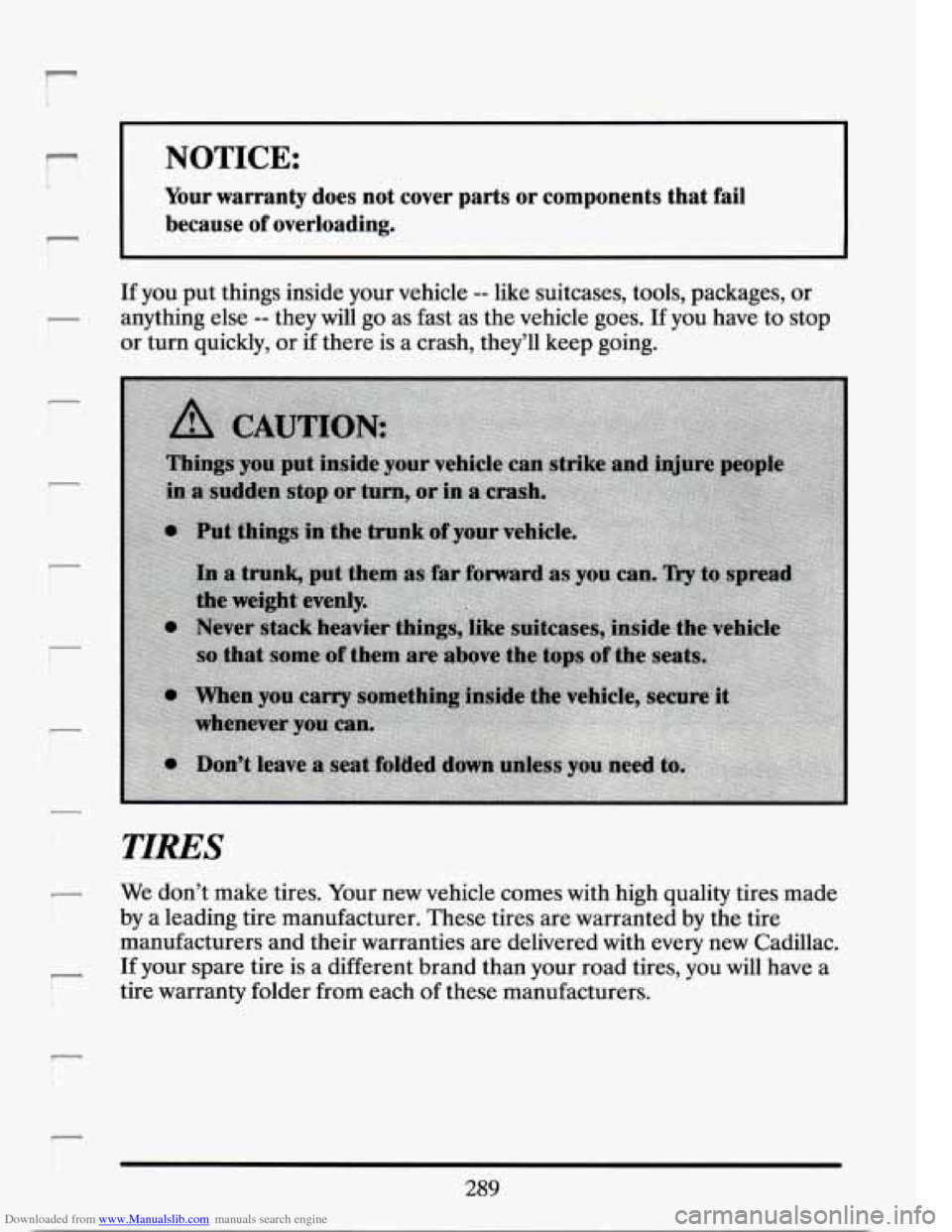
Downloaded from www.Manualslib.com manuals search engine NOTICE:
Your warranty does not cover parts or components that fail
I because of overloading.
I
If you put things inside your vehicle -- like suitcases, tools, packages, or
anything else
-- they will go as fast as the vehicle goes. If you have to stop
or turn quickly, or if there is a crash, they’ll keep going.
7 i
TIRES
i i
We don’t make tires. Your new vehicle comes with high quality tires made
by a leading tire manufacturer. These tires are warranted by the tire
manufacturers and their warranties are delivered with every new Cadillac.
If your spare tire is a different brand than your road tires, you will have a
tire warranty folder from each of these manufacturers.
289
Page 303 of 399
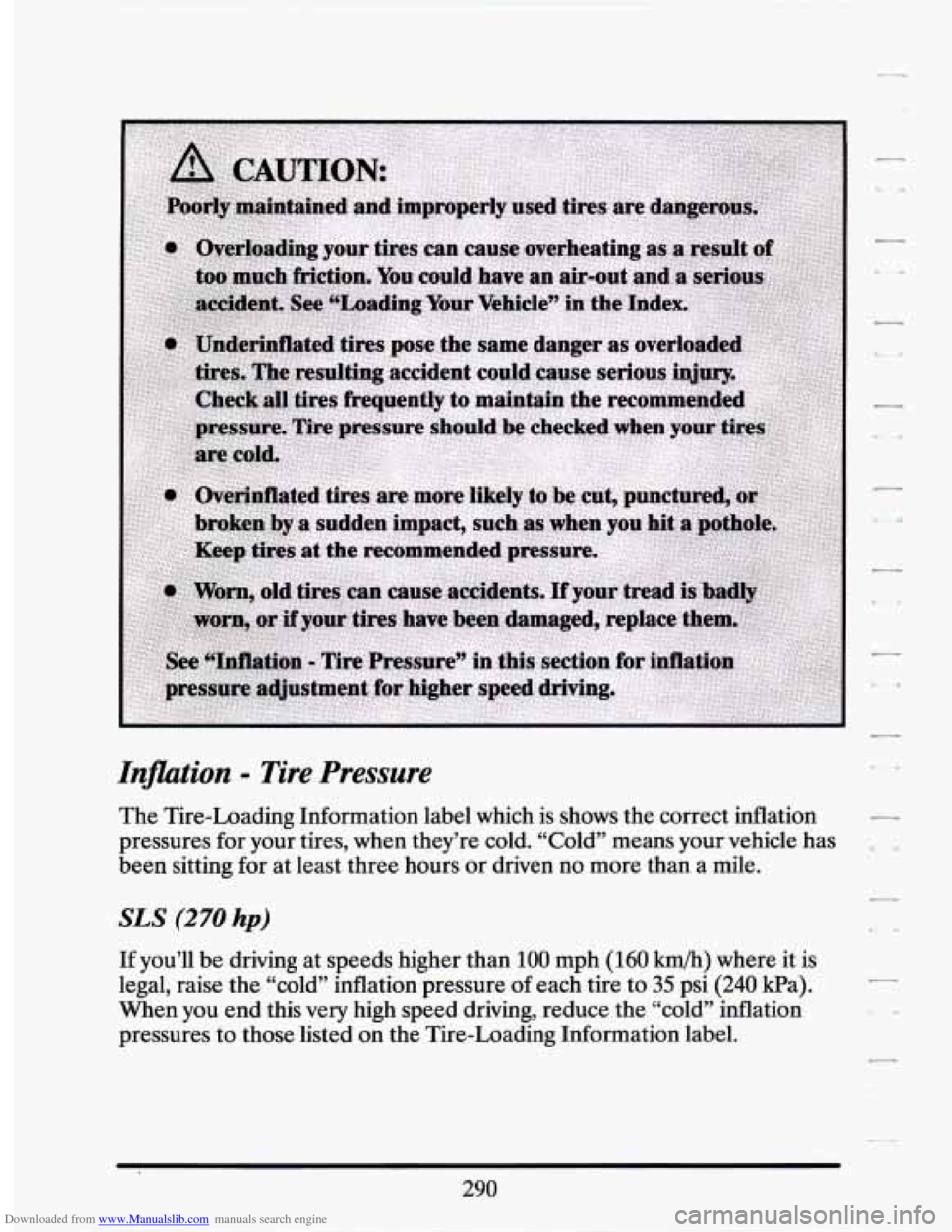
Downloaded from www.Manualslib.com manuals search engine Infition - Tire Pressure
The Tire-Loading Information label which is shows the correct inflation
pressures for your tires, when they’re cold. “Cold” means your vehicle has
been sitting
for at least three hours or driven no more than a mile.
SLS (270 hp)
If you’ll be driving at speeds higher than 100 mph (160 km/h) where it is
legal, raise the “cold” inflation pressure
of each tire to 35 psi (240 kPa).
When you end this
very high speed driving, reduce the “cold” inflation
pressures to those listed
on the Tire-Loading Information label.
290
LY
Page 304 of 399
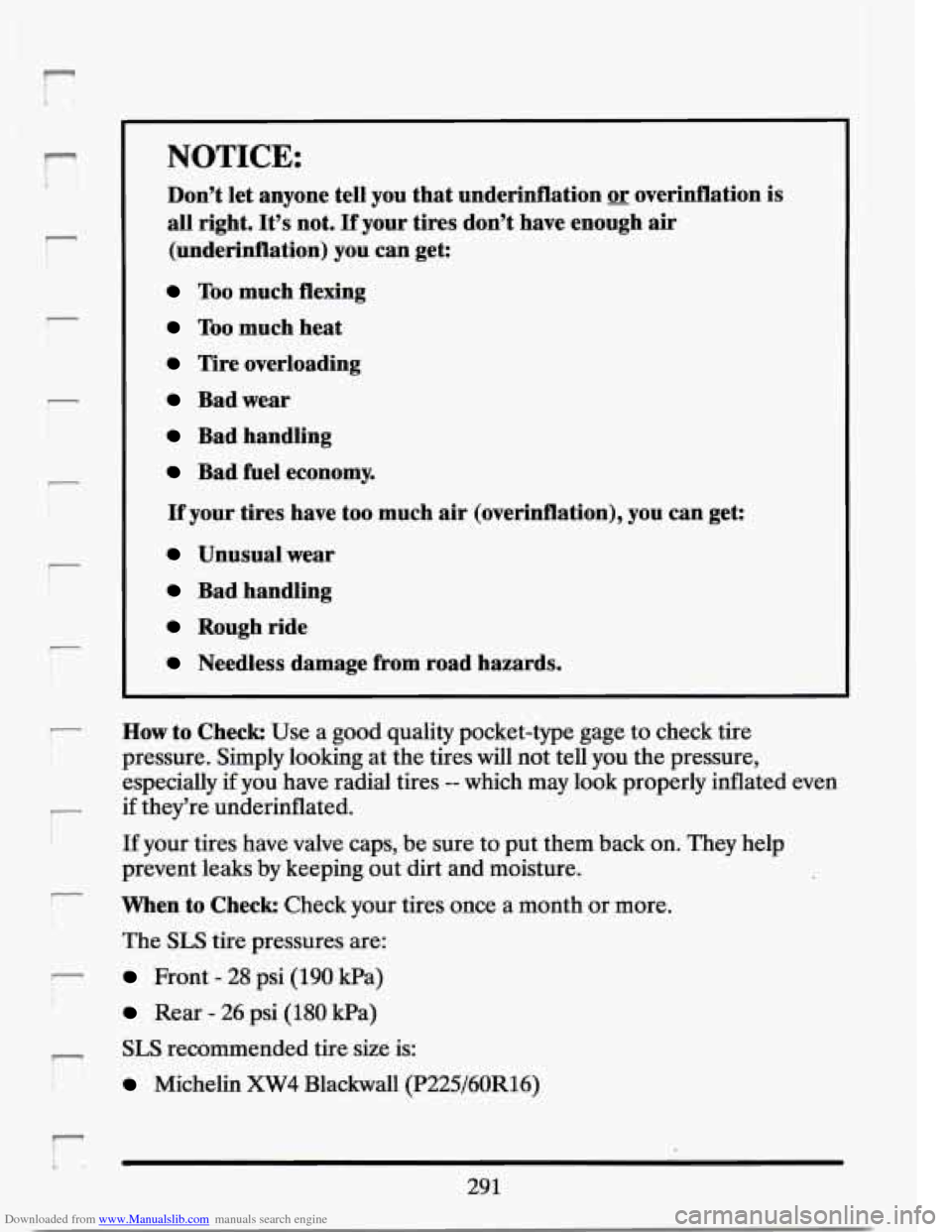
Downloaded from www.Manualslib.com manuals search engine r
f
r
r I 1
i- I
NOTICE:
Don’t let anyone tell you that underidlation or overinflation is
all right. It’s not. If your tires don’t have enough air
(underinflation) you can get:
Too much flexing
Too much heat
Tire overloading
Bad wear
Bad handling
Bad fuel economy.
If your tires have
too much air (overinflation), you can get:
Unusual wear
Bad handling
Rough ride
Needless damage from road hazards.
7 I
!
-
I
How to Check Use a good quality pocket-type gage to check tire
pressure. Simply looking at the tires will not tell you the pressure,
especially if you have radial tires
-- which may look properly inflated even
if they’re underinflated.
If your tires have valve caps, be sure to put them back on. They help
prevent leaks by keeping out dirt and moisture.
When to Check Check your tires once a month or more.
The
SLS tire pressures are:
Front - 28 psi (190 kPa)
Rear - 26 psi (180 Pa)
SLS recommended tire size is:
Michelin XW4 Blackwall (P225/60R16)
291
Page 305 of 399
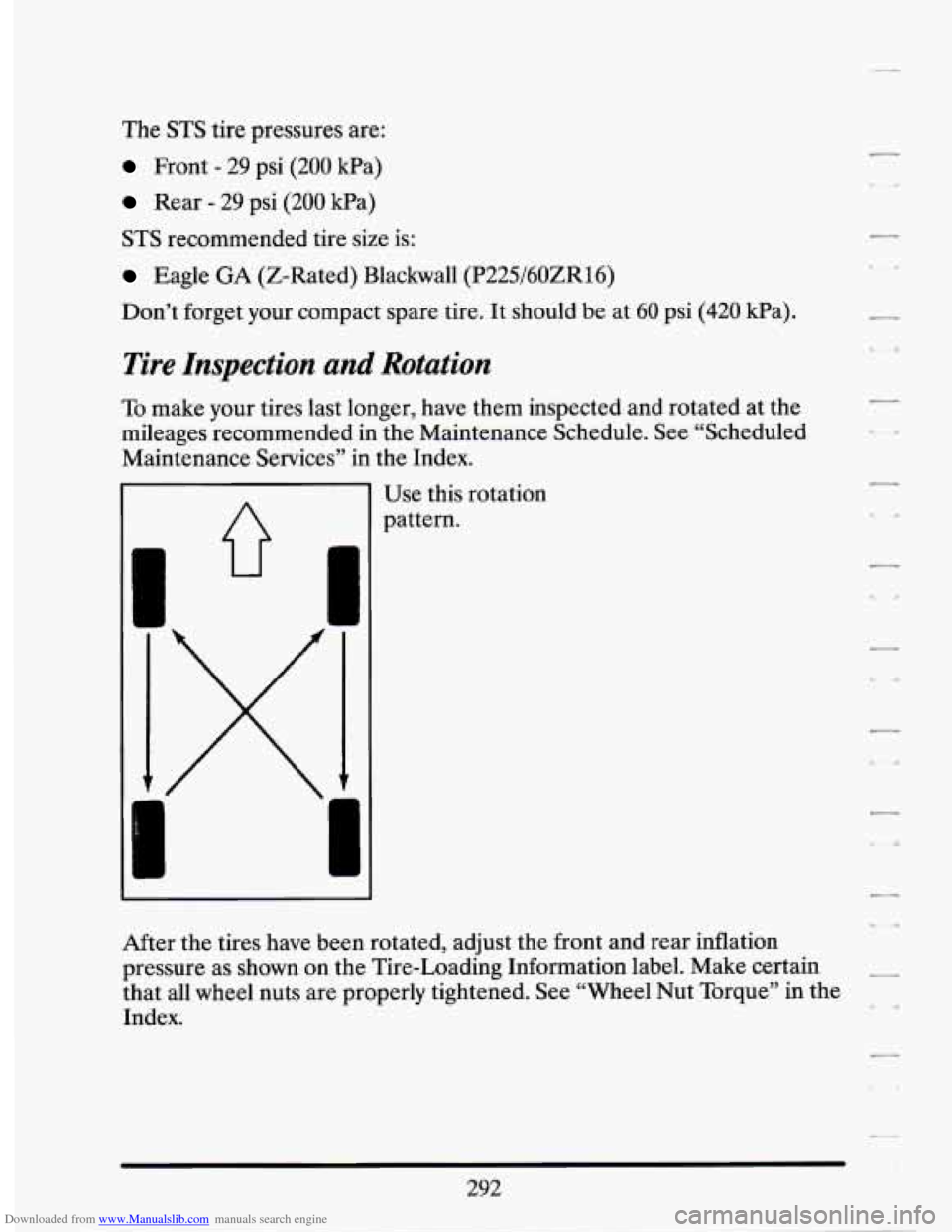
Downloaded from www.Manualslib.com manuals search engine The STS tire pressures are:
Front - 29 psi (200 kPa)
Rear - 29 psi (200 kPa)
STS recommended tire size is:
Eagle GA (2-Rated) Blackwall (P225/60ZR16)
Don’t forget your compact spare tire. It should be at 60 psi
(420 kPa).
Tire Inspection and Rotation
To make your tires last longer, have them inspected and rotated at the
mileages recommended
in the Maintenance Schedule. See “Scheduled
Maintenance Services”
in the Index.
Use this rotation
pattern.
After the tires have been rotated, adjust the front and rear inflation
pressure as shown
on the Tire-Loading Information label. Make certain
that all wheel nuts are properly tightened. See “Wheel Nut Torque” in the
Index.
292
Page 306 of 399
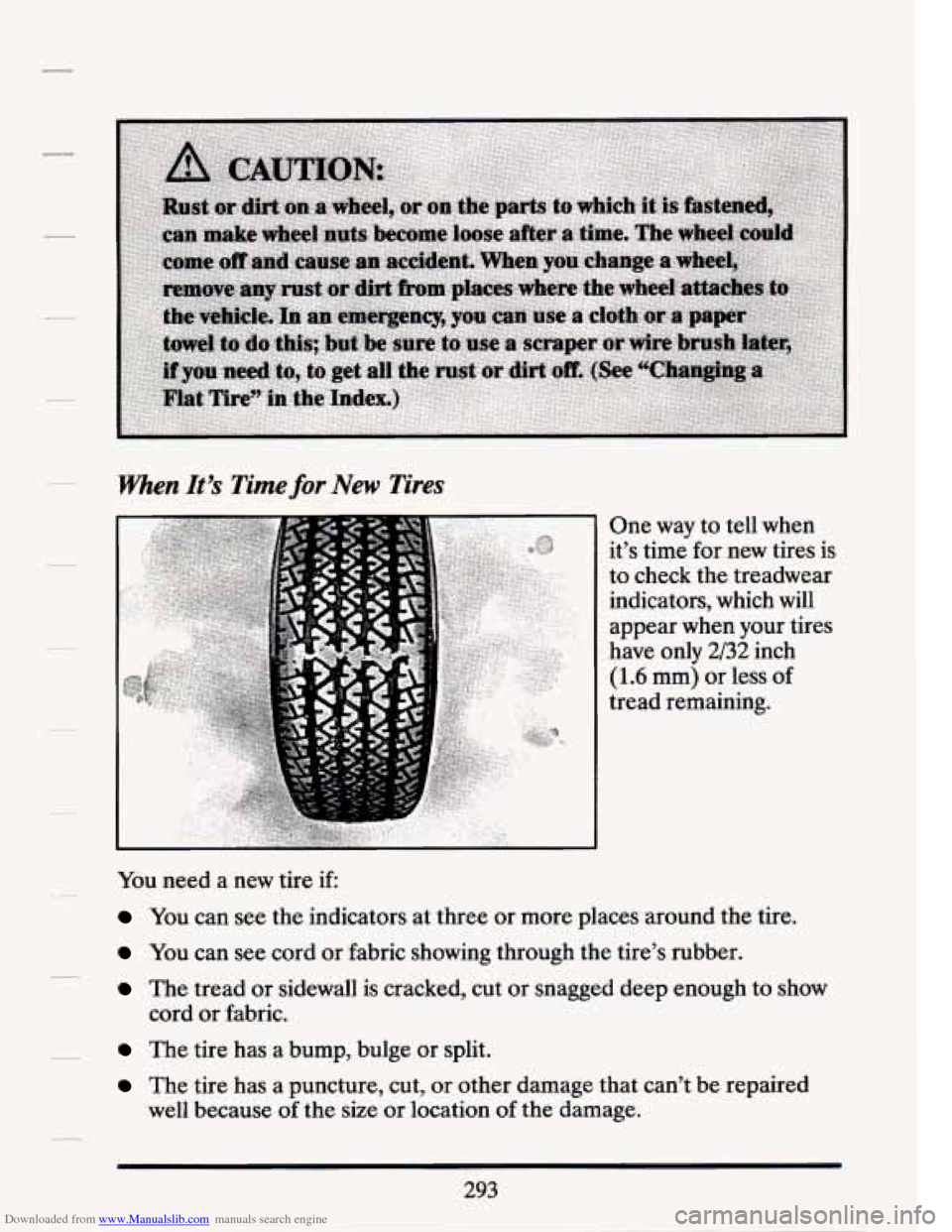
Downloaded from www.Manualslib.com manuals search engine When It’s Time for New Tires
One way to tell when
it’s time for new tires is
to check the treadwear
indicators, which
will
appear when your tires
have only
2/32 inch
(1.6 mm) or less of
tread remaining.
You need
a new tire if:
You can see the indicators at three or more places around the tire.
You can see cord or fabric showing through the tire’s rubber.
The tread or sidewall is cracked, cut or snagged deep enough to show
The tire has a bump, bulge or split.
The tire has a puncture, cut, or other damage that can’t be repaired
cord
or fabric.
well because of the size or location of the damage.
293
Page 307 of 399
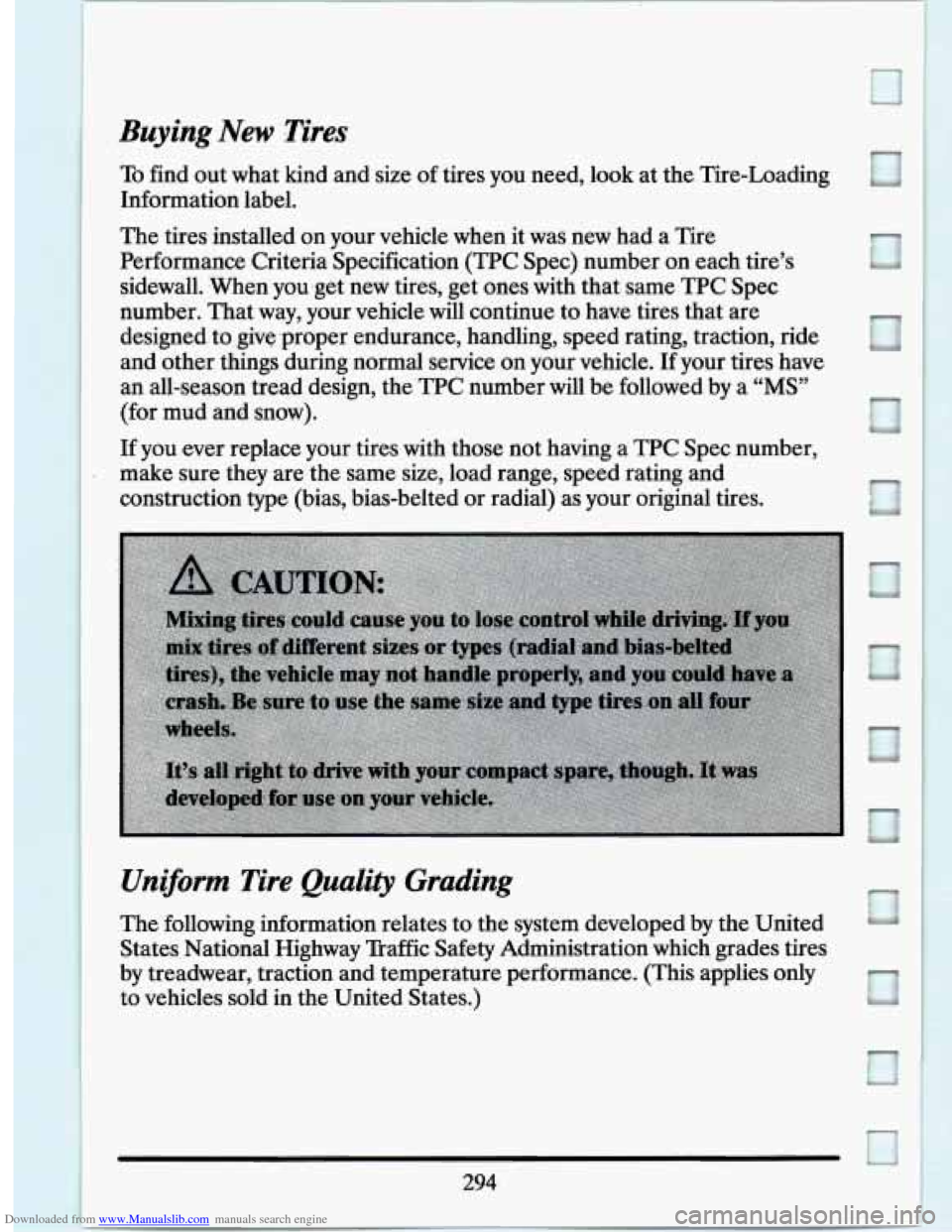
Downloaded from www.Manualslib.com manuals search engine Buying New Tires
To find out what kind and size of tires you need, look at the Tire-Loading
Information label.
The tires installed on your vehicle when it was new had a Tire
Performance Criteria Specification (TPC Spec) number on each tire's
sidewall. When yowget new tires, get ones with that, same TPC Spec
number. That way, your vehicle will continue to have tires that are
designed to give.proper endurance, handling, speed rating, traction, ride
and other things during normal service on 'your vehicle.
If your tires have
an all-season tread design, the- TPC number will be followed by a
"MS"
(for mud and snow).
If you ever replace your tires with those not having a TPC Spec number,
make sure they are the same size, load range, speed rating and
construction type (bias, bias-belted or radial) as your original tires.
Uniform Tire.Quality Grading
The following information relates to the system developed by the United
States National Highway Traffic Safety Administration which grades tires
by treadwear, traction and. temperature performance. (This applies only
to vehicles sold in the United States.)
Page 308 of 399

Downloaded from www.Manualslib.com manuals search engine Treadwear
The treadwear grade is a comparative rating based on the wear rate of
the tire when tested under controlled conditions on a specified
- government test course. For example, a tire graded 150 would wear one
and a half
(1 1/2) times as well on the government course as a tire graded
100. The relative performance of tires depends upon the actual
conditions
of their use, however, and may depart significantly from the
norm due to variations in driving habits, service practices and differences
in road characteristics and climate.
-
__
Traction - A, B, C
The traction grades, from highest to lowest are: A, B, and C. They
represent the tire’s ability to stop on wet pavement as measured under
controlled conditions on specified government test surfaces
of asphalt
and concrete.
A tire marked C may have poor traction performance.
Warning: The traction grade assigned to this tire is based on braking
(straight-ahead) traction tests and does not include cornering (turning)
traction.
Temperature -A, B, C
The temperature grades are A (the highest), B, and C, representing the
when tested under controlled conditions on a specified indoor laboratory
test wheel. Sustained high temperature can cause the material of the tire
to degenerate and reduce tire life, and excessive temperature can lead to
sudden tire failure. The grade.C corresponds to a level
of performance
which all passenger car tires must meet under the Federal Motor Vehicle
Safety Standard
No. 109. Grades B and A represent higher levels of
performance on the laboratory test wheel than the minimum required by
law.
-. - tire’s resistance to the generation of heat and its ability to dissipate heat
_- -
Warning: The temperature grade for this tire is established for a tire that
is properly inflated and not overloaded. Excessive speed, underinflation,
or excessive loading, either separately or
in combination, can cause heat
buildup and possible tire failure.
These grades
are molded on the sidewalls of passenger car tires.
~
295
Page 309 of 399
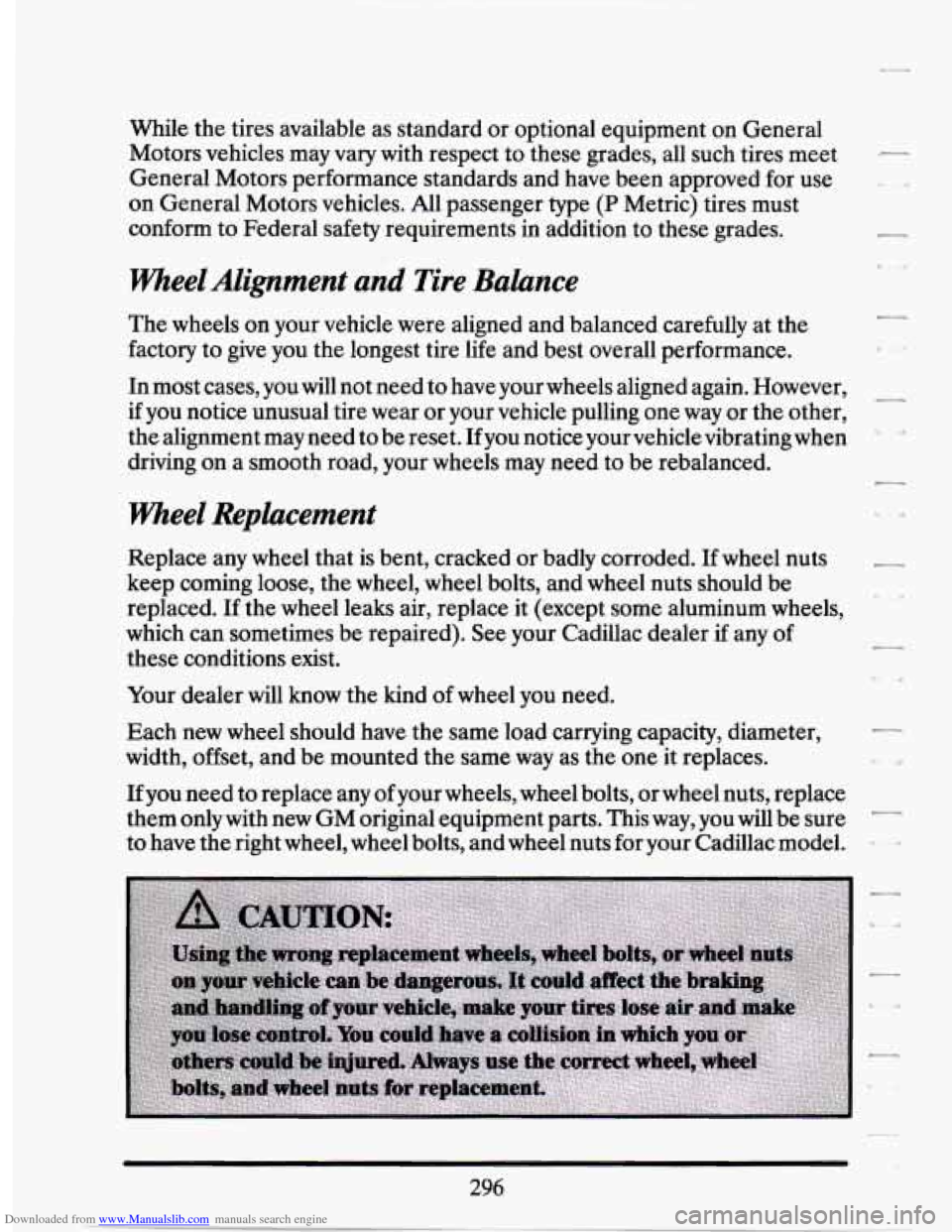
Downloaded from www.Manualslib.com manuals search engine While the tires available as standard or optional equipment on General
Motors vehicles may vary with respect to these grades, all such tires meet
General Motors performance standards and have been approved for use
on General Motors vehicles. All passenger
type (P Metric) tires must
conform to Federal safety requirements in addition to these grades.
Wheel Alignment and Tire Balance
The wheels on your vehicle were aligned and balanced carefully at the
factory to give you the longest tire life and best overall performance.
1
In most cases, you will not need to have your wheels aligned again. However,
if you notice unusual tire wear or your vehicle pulling one way or the other,
the alignment may need to be reset. If you notice your vehicle vibrating when
driving on a smooth road, your wheels may need to be rebalanced.
-
Wheel Replacement
Replace any wheel that is bent, cracked or badly corroded. If wheel nuts
keep coming loose, the wheel, wheel bolts, and wheel nuts should be
replaced.
If the wheel leaks air, replace it (except some aluminum wheels,
which can sometimes be repaired). See your Cadillac dealer
if any of
these conditions exist.
Your dealer will know the kind
of wheel you need.
Each new wheel should have the same load carrying capacity, diameter,
width, offset, and be mounted the same way as the one it replaces.
If you need to replace any of your wheels, wheel bolts, or wheel nuts, replace
them only with new GM original equipment parts. This way, you will be sure
-
to have the right wheel, wheel bolts, and wheel nuts for your Cadillac model.
296
Page 310 of 399
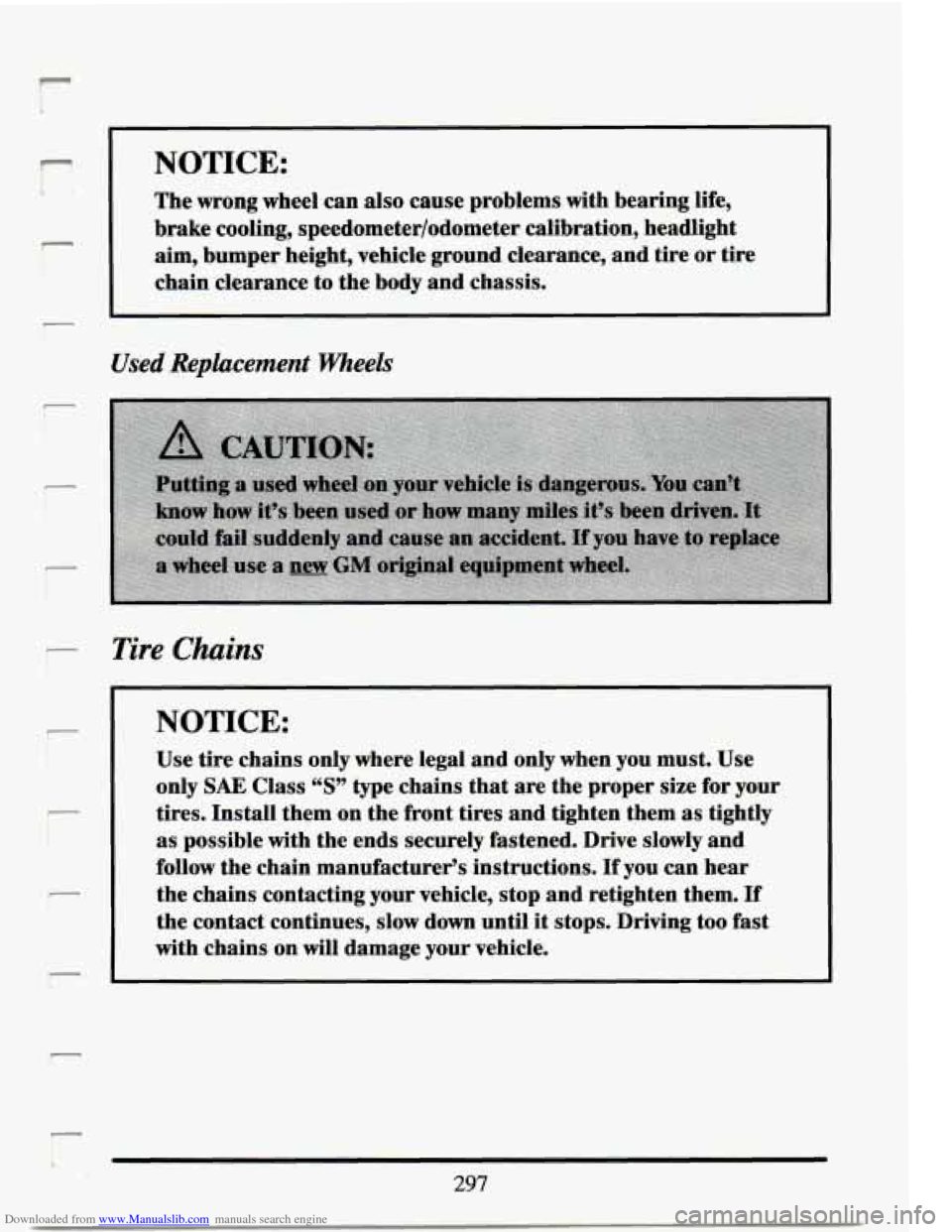
Downloaded from www.Manualslib.com manuals search engine r
NOTICE: I
The wrong wheel can also cause problems with bearing life,
brake cooling, speedometer/odometer calibration, headlight
aim, bumper height, vehicle ground clearance, and tire or tire
chain clearance to the body and chassis.
c I -
r
r-
Used Replacement Wheels
rire Chains
NOTICE:
Use tire chains only where legal and only when you must. Use
only
SAE Class “S” type chains that are the proper size for your
tires. Install them on the front tires and tighten them
as tightly
as possible with the ends securely fastened. Drive slowly and
follow the chain manufacturer‘s instructions.
If you can hear
the chains contacting your vehicle, stop and retighten them.
If
the contact continues, slow down until it stops. Driving too fast
with chains on will damage your vehicle.
297